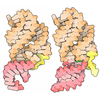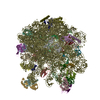[English] 日本語
 Yorodumi
Yorodumi- PDB-8p8b: Mycoplasma pneumoniae large ribosomal subunit in chloramphenicol-... -
+ Open data
Open data
- Basic information
Basic information
| Entry | Database: PDB / ID: 8p8b | |||||||||
|---|---|---|---|---|---|---|---|---|---|---|
| Title | Mycoplasma pneumoniae large ribosomal subunit in chloramphenicol-treated cells | |||||||||
 Components Components |
| |||||||||
 Keywords Keywords | TRANSLATION / In situ / Ribosome / Chloramphenicol / cryo-ET | |||||||||
| Function / homology |  Function and homology information Function and homology informationpeptidylprolyl isomerase / peptidyl-prolyl cis-trans isomerase activity / protein folding / protein transport / large ribosomal subunit / transferase activity / 5S rRNA binding / ribosomal large subunit assembly / large ribosomal subunit rRNA binding / cytosolic large ribosomal subunit ...peptidylprolyl isomerase / peptidyl-prolyl cis-trans isomerase activity / protein folding / protein transport / large ribosomal subunit / transferase activity / 5S rRNA binding / ribosomal large subunit assembly / large ribosomal subunit rRNA binding / cytosolic large ribosomal subunit / cytoplasmic translation / tRNA binding / negative regulation of translation / rRNA binding / structural constituent of ribosome / ribosome / translation / ribonucleoprotein complex / cell division / response to antibiotic / mRNA binding / cytoplasm Similarity search - Function | |||||||||
| Biological species |  Mycoplasmoides pneumoniae M129 (bacteria) Mycoplasmoides pneumoniae M129 (bacteria) | |||||||||
| Method | ELECTRON MICROSCOPY / subtomogram averaging / cryo EM / Resolution: 2.9 Å | |||||||||
 Authors Authors | Schacherl, M. / Xue, L. / Spahn, C.M.T. / Mahamid, J. | |||||||||
| Funding support |  United States, United States,  Germany, 2items Germany, 2items
| |||||||||
 Citation Citation |  Journal: Nat Struct Mol Biol / Year: 2025 Journal: Nat Struct Mol Biol / Year: 2025Title: Structural insights into context-dependent inhibitory mechanisms of chloramphenicol in cells. Authors: Liang Xue / Christian M T Spahn / Magdalena Schacherl / Julia Mahamid /   Abstract: Ribosome-targeting antibiotics represent an important class of antimicrobial drugs. Chloramphenicol (Cm) is a well-studied ribosomal peptidyl transferase center (PTC) binder and growing evidence ...Ribosome-targeting antibiotics represent an important class of antimicrobial drugs. Chloramphenicol (Cm) is a well-studied ribosomal peptidyl transferase center (PTC) binder and growing evidence suggests that its inhibitory action depends on the sequence of the nascent peptide. How such selective inhibition on the molecular scale manifests on the cellular level remains unclear. Here, we use cryo-electron tomography to analyze the impact of Cm inside the bacterium Mycoplasma pneumoniae. By resolving the Cm-bound ribosomes to 3.0 Å, we elucidate Cm's coordination with natural nascent peptides and transfer RNAs in the PTC. We find that Cm leads to the accumulation of a number of translation elongation states, indicating ongoing futile accommodation cycles, and to extensive ribosome collisions. We, thus, suggest that, beyond its direct inhibition of protein synthesis, the action of Cm may involve the activation of cellular stress responses. This work exemplifies how in-cell structural biology can expand the understanding of mechanisms of action for extensively studied antibiotics. | |||||||||
| History |
|
- Structure visualization
Structure visualization
| Structure viewer | Molecule:  Molmil Molmil Jmol/JSmol Jmol/JSmol |
|---|
- Downloads & links
Downloads & links
- Download
Download
| PDBx/mmCIF format |  8p8b.cif.gz 8p8b.cif.gz | 2.4 MB | Display |  PDBx/mmCIF format PDBx/mmCIF format |
|---|---|---|---|---|
| PDB format |  pdb8p8b.ent.gz pdb8p8b.ent.gz | 1.9 MB | Display |  PDB format PDB format |
| PDBx/mmJSON format |  8p8b.json.gz 8p8b.json.gz | Tree view |  PDBx/mmJSON format PDBx/mmJSON format | |
| Others |  Other downloads Other downloads |
-Validation report
| Summary document |  8p8b_validation.pdf.gz 8p8b_validation.pdf.gz | 746.3 KB | Display |  wwPDB validaton report wwPDB validaton report |
|---|---|---|---|---|
| Full document |  8p8b_full_validation.pdf.gz 8p8b_full_validation.pdf.gz | 828.6 KB | Display | |
| Data in XML |  8p8b_validation.xml.gz 8p8b_validation.xml.gz | 104 KB | Display | |
| Data in CIF |  8p8b_validation.cif.gz 8p8b_validation.cif.gz | 178.1 KB | Display | |
| Arichive directory |  https://data.pdbj.org/pub/pdb/validation_reports/p8/8p8b https://data.pdbj.org/pub/pdb/validation_reports/p8/8p8b ftp://data.pdbj.org/pub/pdb/validation_reports/p8/8p8b ftp://data.pdbj.org/pub/pdb/validation_reports/p8/8p8b | HTTPS FTP |
-Related structure data
| Related structure data |  17134MC  8p6pC  8p7xC  8p7yC  8p8vC  8p8wC M: map data used to model this data C: citing same article ( |
|---|---|
| Similar structure data | Similarity search - Function & homology  F&H Search F&H Search |
| Experimental dataset #1 | Data reference:  10.6019/EMPIAR-11520 / Data set type: EMPIAR 10.6019/EMPIAR-11520 / Data set type: EMPIAR |
- Links
Links
- Assembly
Assembly
| Deposited unit | 
|
|---|---|
| 1 |
|
- Components
Components
+50S ribosomal protein ... , 29 types, 29 molecules 012abcdefghijklmnopqrstuvwxyz
-RNA chain , 7 types, 7 molecules 345678Y
| #4: RNA chain | Mass: 940953.500 Da / Num. of mol.: 1 / Source method: isolated from a natural source / Source: (natural)  Mycoplasmoides pneumoniae M129 (bacteria) / References: GenBank: 26117688 Mycoplasmoides pneumoniae M129 (bacteria) / References: GenBank: 26117688 |
|---|---|
| #5: RNA chain | Mass: 34796.676 Da / Num. of mol.: 1 / Source method: isolated from a natural source / Source: (natural)  Mycoplasmoides pneumoniae M129 (bacteria) / References: GenBank: 26117688 Mycoplasmoides pneumoniae M129 (bacteria) / References: GenBank: 26117688 |
| #6: RNA chain | Mass: 491327.844 Da / Num. of mol.: 1 / Source method: isolated from a natural source Details: Sequence comprises 16S rRNA ribonucleotides 1374-1387 and 1463-1480 only. Source: (natural)  Mycoplasmoides pneumoniae M129 (bacteria) / References: GenBank: 26117688 Mycoplasmoides pneumoniae M129 (bacteria) / References: GenBank: 26117688 |
| #7: RNA chain | Mass: 24440.492 Da / Num. of mol.: 1 / Source method: isolated from a natural source / Source: (natural)  Mycoplasmoides pneumoniae M129 (bacteria) / References: GenBank: 26117688 Mycoplasmoides pneumoniae M129 (bacteria) / References: GenBank: 26117688 |
| #8: RNA chain | Mass: 24136.244 Da / Num. of mol.: 1 / Source method: isolated from a natural source / Source: (natural)  Mycoplasmoides pneumoniae M129 (bacteria) / References: GenBank: 26117688 Mycoplasmoides pneumoniae M129 (bacteria) / References: GenBank: 26117688 |
| #9: RNA chain | Mass: 24401.449 Da / Num. of mol.: 1 / Source method: isolated from a natural source / Source: (natural)  Mycoplasmoides pneumoniae M129 (bacteria) / References: GenBank: 26117688 Mycoplasmoides pneumoniae M129 (bacteria) / References: GenBank: 26117688 |
| #11: RNA chain | Mass: 2894.807 Da / Num. of mol.: 1 / Source method: isolated from a natural source / Source: (natural)  Mycoplasmoides pneumoniae M129 (bacteria) Mycoplasmoides pneumoniae M129 (bacteria) |
-Protein / Protein/peptide , 2 types, 2 molecules XZ
| #10: Protein | Mass: 51427.031 Da / Num. of mol.: 1 / Source method: isolated from a natural source / Source: (natural)  Mycoplasmoides pneumoniae M129 (bacteria) / References: UniProt: P75454, peptidylprolyl isomerase Mycoplasmoides pneumoniae M129 (bacteria) / References: UniProt: P75454, peptidylprolyl isomerase |
|---|---|
| #12: Protein/peptide | Mass: 3127.794 Da / Num. of mol.: 1 / Source method: isolated from a natural source / Source: (natural)  Mycoplasmoides pneumoniae M129 (bacteria) Mycoplasmoides pneumoniae M129 (bacteria) |
-Non-polymers , 9 types, 266 molecules 



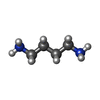
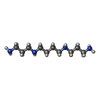
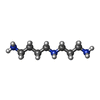

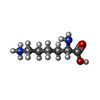








| #39: Chemical | ChemComp-ZN / #40: Chemical | ChemComp-CLM / | #41: Chemical | ChemComp-K / | #42: Chemical | ChemComp-MG / #43: Chemical | ChemComp-PUT / #44: Chemical | ChemComp-SPM / #45: Chemical | ChemComp-SPD / #46: Chemical | #47: Chemical | ChemComp-LYS / | |
|---|
-Details
| Has ligand of interest | Y |
|---|---|
| Has protein modification | Y |
-Experimental details
-Experiment
| Experiment | Method: ELECTRON MICROSCOPY |
|---|---|
| EM experiment | Aggregation state: CELL / 3D reconstruction method: subtomogram averaging |
- Sample preparation
Sample preparation
| Component | Name: Large ribosomal subunit with some elements of the small ribosomal subunit. Focused refinement on 50S subunit of the in situ 70S subunit map. Type: CELL Details: Mycoplasma pneumoniae M129 cells treated with chloramphenicol Entity ID: #1-#8, #10-#38 / Source: NATURAL |
|---|---|
| Source (natural) | Organism:  Mycoplasmoides pneumoniae M129 (bacteria) Mycoplasmoides pneumoniae M129 (bacteria) |
| Buffer solution | pH: 7.4 Details: The modified Hayflick medium: 14.7g/L Difco PPLO(Becton Dickinson), 20% (v/v) Gibco horse serum(New Zealand origin), 100 mM HEPES-Na; pH 7.4, 1% (w/w) glucose, 0.002% (w/w) phenol red, 1000 U/mL penicillin G. |
| Specimen | Embedding applied: NO / Shadowing applied: NO / Staining applied: NO / Vitrification applied: YES Details: Mycoplasma pneumoniae M129 cells were grown on gold Quantifoil grids at 37 Celsius in the modified Hayflick medium. Treatment with chloramphenicol at the final concentration of 0.2 mg/ml was ...Details: Mycoplasma pneumoniae M129 cells were grown on gold Quantifoil grids at 37 Celsius in the modified Hayflick medium. Treatment with chloramphenicol at the final concentration of 0.2 mg/ml was performed for about 15 minutes before plunge freezing. |
| Specimen support | Grid material: GOLD / Grid mesh size: 200 divisions/in. / Grid type: Quantifoil R2/1 |
| Vitrification | Instrument: HOMEMADE PLUNGER / Cryogen name: ETHANE-PROPANE Details: Back-side blotting for 2-3 seconds before plunging using a manual plunger without an environmental control chamber. |
- Electron microscopy imaging
Electron microscopy imaging
| Experimental equipment |  Model: Titan Krios / Image courtesy: FEI Company |
|---|---|
| Microscopy | Model: FEI TITAN KRIOS |
| Electron gun | Electron source:  FIELD EMISSION GUN / Accelerating voltage: 300 kV / Illumination mode: FLOOD BEAM FIELD EMISSION GUN / Accelerating voltage: 300 kV / Illumination mode: FLOOD BEAM |
| Electron lens | Mode: BRIGHT FIELD / Nominal magnification: 64000 X / Nominal defocus max: 3250 nm / Nominal defocus min: 1000 nm / Cs: 2.7 mm / Alignment procedure: COMA FREE |
| Specimen holder | Cryogen: NITROGEN / Specimen holder model: FEI TITAN KRIOS AUTOGRID HOLDER |
| Image recording | Electron dose: 3.34 e/Å2 / Avg electron dose per subtomogram: 137 e/Å2 / Film or detector model: GATAN K3 BIOQUANTUM (6k x 4k) / Num. of real images: 1 Details: Gatan K3 camera in non-CDS counting mode, targeted dose rate on camera ~20 e/pixel/second, 10 frames per tilt image, constant exposure time for each tilt, pixel size 1.329A |
| EM imaging optics | Energyfilter name: GIF Bioquantum / Energyfilter slit width: 20 eV |
- Processing
Processing
| EM software |
| |||||||||||||||||||||||||||||||||||||||||||||||||||||||||||||||||
|---|---|---|---|---|---|---|---|---|---|---|---|---|---|---|---|---|---|---|---|---|---|---|---|---|---|---|---|---|---|---|---|---|---|---|---|---|---|---|---|---|---|---|---|---|---|---|---|---|---|---|---|---|---|---|---|---|---|---|---|---|---|---|---|---|---|---|
| CTF correction | Details: CTF estimation and 3D CTF correction are done in Warp Type: PHASE FLIPPING AND AMPLITUDE CORRECTION | |||||||||||||||||||||||||||||||||||||||||||||||||||||||||||||||||
| Symmetry | Point symmetry: C1 (asymmetric) | |||||||||||||||||||||||||||||||||||||||||||||||||||||||||||||||||
| 3D reconstruction | Resolution: 2.9 Å / Resolution method: FSC 0.143 CUT-OFF / Num. of particles: 30774 / Algorithm: FOURIER SPACE / Details: half maps from Warp/M / Symmetry type: POINT | |||||||||||||||||||||||||||||||||||||||||||||||||||||||||||||||||
| EM volume selection | Num. of tomograms: 139 / Num. of volumes extracted: 30774 | |||||||||||||||||||||||||||||||||||||||||||||||||||||||||||||||||
| Atomic model building | Protocol: RIGID BODY FIT / Space: REAL / Target criteria: Cross-correlation coefficient | |||||||||||||||||||||||||||||||||||||||||||||||||||||||||||||||||
| Atomic model building |
| |||||||||||||||||||||||||||||||||||||||||||||||||||||||||||||||||
| Refine LS restraints |
|
 Movie
Movie Controller
Controller

















 PDBj
PDBj











